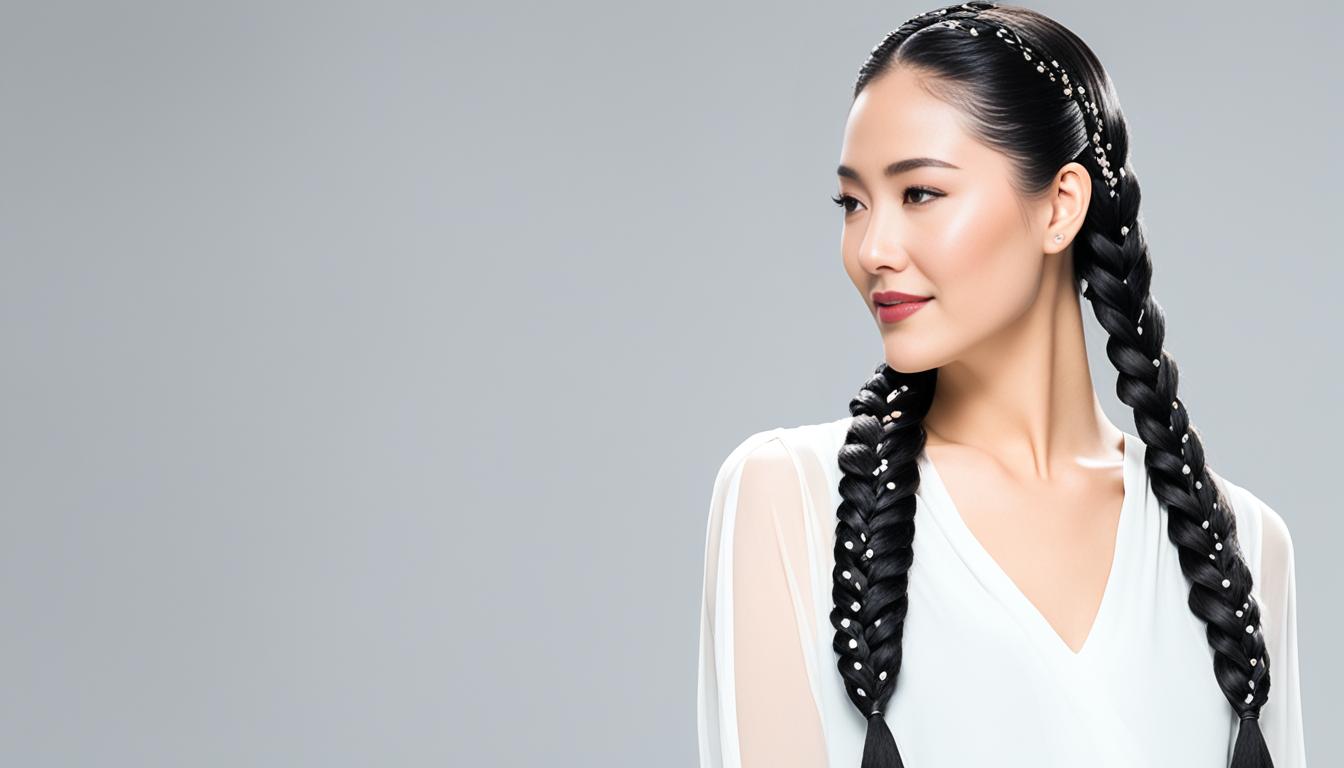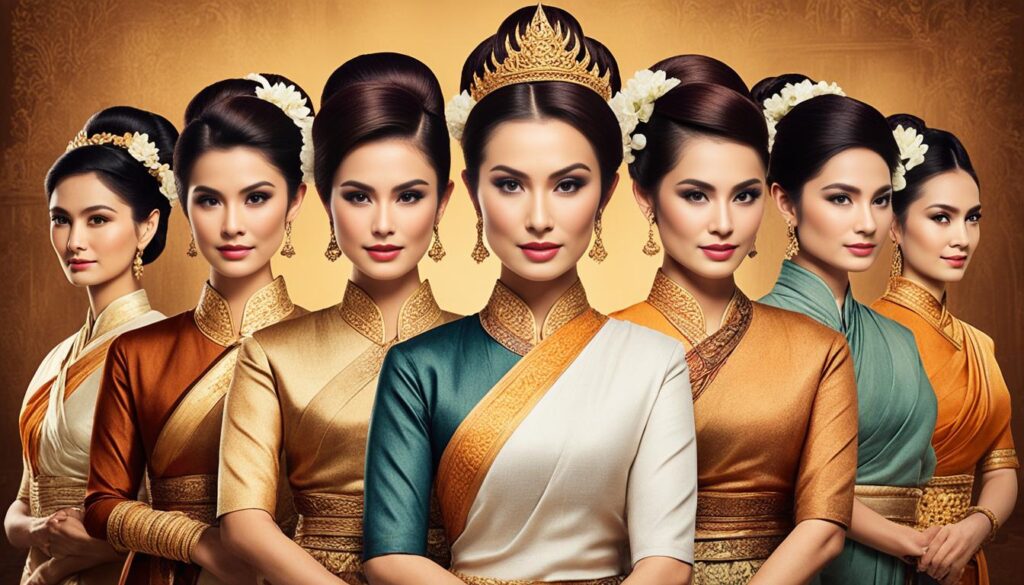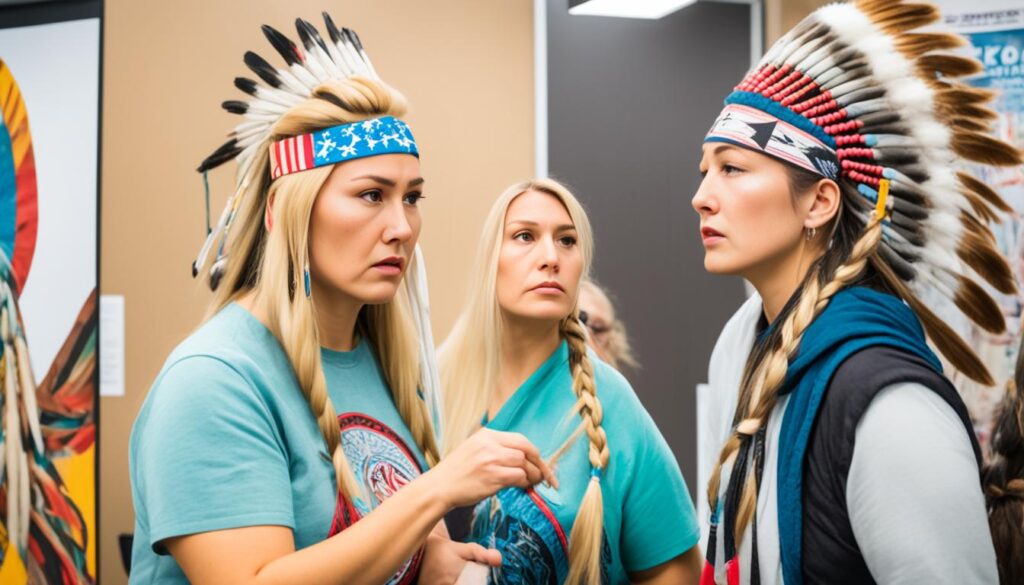
When you think of braided hairstyles, what comes to mind? African culture, perhaps? While it’s true that the origins of braids can be traced back to Africa, did you know that braided hairstyles have also been prevalent in Asian cultures for centuries? From China to Thailand to India, braiding traditions have played a significant role in Asian hair traditions and cultural expressions of beauty.
In this article, we will delve into the history of braids in Asia, exploring the cultural significance of braided hair in Asian societies and the unique braiding customs that have evolved over time. We will also discuss the importance of understanding and appreciating these hairstyles to avoid cultural appropriation and promote cultural diversity.
So, did Asians have braids? Let’s uncover the fascinating world of Asian braided hairstyles and discover the rich tapestry of traditions and customs that have shaped the way Asian individuals style their hair.
Key Takeaways:
- Asian cultures have a rich history of braided hairstyles, showcasing the beauty and diversity of different traditions.
- Braids in Asia have been used to convey messages, protect against evil spirits, and showcase individuality.
- Understanding the cultural significance and history behind Asian braided hairstyles is crucial to avoid cultural appropriation.
- Appreciating and respecting the roots of these hairstyles promotes cultural diversity and inclusivity.
- By embracing the beauty of different cultures, we can celebrate the variety and uniqueness of braided hairstyles throughout history.
History of Chinese Braids
In ancient China, braided hairstyles held great significance and were used as a form of communication. Women adorned their hair with various braid styles to convey messages, express their social status, or mark important life events. Let’s explore the fascinating history of Chinese braids and the unique styles that emerged.
Unmarried girls in ancient China usually wore their hair down as a symbol of their youth and innocence. It was a simple yet elegant style that showcased their natural beauty.
However, when young maidens reached the age of fifteen, they underwent a special ceremony called the Ji Li. During this ceremony, their hair was twisted into intricate braided updos adorned with ornamental pins. These elaborate braided hairstyles symbolized their transition into womanhood and marked an important milestone in their lives.
“The Ji Li ceremony was a grand affair where young maidens would gather with their families and friends to celebrate this coming-of-age event. The intricate braided updos were a testament to their grace, beauty, and maturity.”
For married women, the Tied The Knot hairstyle was a common choice. This style involved braiding the hair at the nape of the neck and securing it with a silk or fabric tie. The Tied The Knot hairstyle represented the bond of marriage and was a symbol of marital status.
The specific braided hairstyles in ancient China varied depending on social status and luxury. Wealthy women had access to more elaborate designs and embellishments, while commoners would opt for simpler braided styles.
| Braid Style | Description |
|---|---|
| Unmarried Girl’s Hair | A simple and natural style, with hair worn down to symbolize youth and innocence. |
| Ji Li Ceremony Braids | Intricate braided updos adorned with ornamental pins, worn by young maidens during the coming-of-age Ji Li ceremony. |
| Tied The Knot | Braided hairstyle at the nape of the neck, secured with a silk or fabric tie, worn by married women to symbolize their marital status. |
The history of Chinese braids not only showcases the creativity and artistry of hairstyling in ancient times but also reflects the cultural values and traditions of the Chinese people. These hairstyles were not just fashionable choices but carried profound meanings and messages.
As we delve deeper into the history of braided hairstyles, we can appreciate the cultural significance they hold in different societies. Each style tells a story and contributes to the diverse tapestry of global hair traditions.
History of Thai Braids
Traditional braided hairstyles in Thailand have a rich history known as Phom Pia. These intricate braids greatly resemble African box braids but with a distinct Thai twist. Unlike other cultures, Thai braids are typically worn with natural hair and no extensions, showcasing a deep connection to the country’s traditions.
Braiding holds significant cultural importance in Thailand, with children often wearing braids as a means of protection against evil spirits. Thai superstitions believe that braids act as a barrier, keeping negative energies at bay and promoting good luck. The intricate patterns and designs celebrated in Thai braids reflect a unique artistic expression.
“Braiding is not just about fashion in Thai culture; it represents our beliefs and traditions. It is a way of honoring our ancestors and protecting ourselves from spiritual harm.” – Tanapat, a Thai cultural expert.
It’s important to understand the historical and cultural significance of Thai braids to avoid cultural appropriation. The practice of adding additional hair or extensions to Thai braids can be seen as disrespectful and insensitive to the black community, as it dilutes the authenticity and origins of these hairstyles.
Recognizing and respecting the history behind braided hairstyles is essential in promoting cultural sensitivity and appreciation. By embracing the uniqueness of Thai braiding traditions and avoiding cultural appropriation, we can celebrate the diversity and beauty of different cultures.
Phom Pia hairstyle
The Phom Pia hairstyle is a stunning example of Thai braiding traditions. It involves intricately weaving the hair into a pattern that resembles a cornrow-like design, starting from the front of the head and extending to the nape of the neck. The Phom Pia hairstyle showcases the artistry and craftsmanship of Thai braiders, with each braided section contributing to a beautiful overall aesthetic.
Below is an example of the Phom Pia hairstyle:
| Phom Pia Hairstyle | Description |
|---|---|
 | A traditional Thai braided hairstyle featuring intricate woven patterns. The Phom Pia hairstyle is often worn with natural hair and no extensions. |
History of Indian Braids
The history of Indian braids is deeply intertwined with the cultural and religious traditions of Hinduism. One of the most prominent hairstyles associated with Indian culture is dreadlocks, which date back to the ancient Vedic Hindu culture in India. These sacred hairstyles are often attributed to Lord Shiva, one of the principal deities in Hinduism.

Dreadlocks, or “jaṭā” in Sanskrit, involve intentionally matting or braiding the hair to form long, rope-like strands. They are symbolic of a devotee’s fear and reverence for the Almighty, embracing a humble and ascetic way of life. The influence of Hinduism and dreadlocks has transcended boundaries, spreading to other religions like Jainism and Buddhism. In fact, historical records suggest that dreadlocks were also prevalent in ancient Roman and Greek cultures.
In contemporary times, Indian women continue to embrace braided hairstyles as a way to enhance their beauty. These hairstyles feature intricate and tight braiding techniques that are often adorned with accessories such as ribbons or flowers. The evolution of Indian braided hairstyles showcases the fusion of religious and cultural influences, combining tradition and modern aesthetics.
In Hindu culture, braiding the hair is not only a symbol of beauty but also carries spiritual significance. It represents the harmonious union of the individual with the divine and is considered an essential part of religious rituals and ceremonies. Braids are often adorned with flowers or embellishments to enhance their elegance and ornamental value.
Overall, the history of Indian braids reflects the rich cultural heritage of the country and the deep-rooted influence of Hinduism. These braided hairstyles not only serve as a form of self-expression and celebration of beauty but also hold immense religious and cultural significance.
Cultural Awareness and Appropriation
Cultural appropriation is a contentious topic, particularly when it comes to hairstyles. It refers to the adoption of specific hairstyles from a culture without giving credit or respecting its origins.
“Cultural appropriation is taking from a culture without giving it credit. It’s important to acknowledge the history and significance of braided hairstyles.”
One high-profile example of cultural appropriation is when Kim Kardashian was criticized for claiming cornrows as a new trend without acknowledging their African roots.
| Example | Explanation |
|---|---|
| Kim Kardashian wearing cornrows | Highlighted the issue of cultural appropriation |
It is essential for individuals, especially those within Asian communities, to be culturally aware and knowledgeable about the history and significance of braided hairstyles.
Why Cultural Awareness is Important
- Respecting and honoring cultural traditions and practices
- Avoiding perpetuation of stereotypes and misrepresentation
- Fostering understanding and appreciation of diverse cultures
The roots of these braided hairstyles go beyond trends and aesthetics; they hold deep cultural and historical significance. By understanding and respecting the origins of these styles, cultural appropriation can be avoided.

How to Avoid Cultural Appropriation
- Educate yourself about the history and cultural significance of braided hairstyles
- Seek permission and guidance from individuals belonging to the culture before adopting the style
- Give credit and acknowledge the origins of the hairstyle
- Avoid commodifying or commercializing cultural practices without understanding their context
- Embrace cultural diversity and celebrate the beauty of different traditions
By promoting cultural awareness and respecting the roots of various braided hairstyles, we can create a society that appreciates and values cultural diversity.
Conclusion
Asian cultures have a rich history of braided hairstyles, each with their own unique traditions and significance. It is important to appreciate and respect the cultural heritage of these hairstyles while avoiding cultural appropriation.
While braids were originally invented in African culture, they have been embraced and adapted by various Asian countries throughout history. Understanding the roots and cultural significance of these braided hairstyles is crucial to avoiding cultural insensitivity and appreciating the beauty of different cultures.
By educating ourselves about the history of Asian braids and the cultural diversity they represent, we can embrace and celebrate the beauty of these hairstyles without appropriating them. It is important to approach Asian braided hairstyles with cultural awareness and respect, acknowledging their origins and honoring the traditions behind them.
By fostering cultural diversity and promoting appreciation for Asian braided hairstyles, we can create a more inclusive and respectful society. Let us celebrate the beauty and significance of braids in Asian cultures while respecting their history and cultural heritage.






